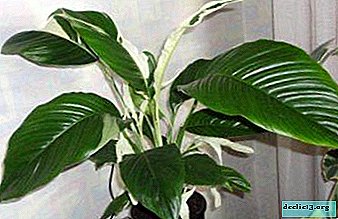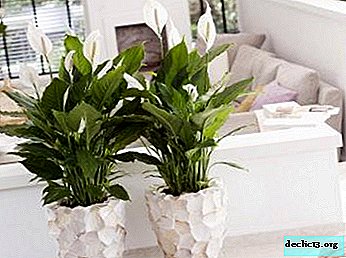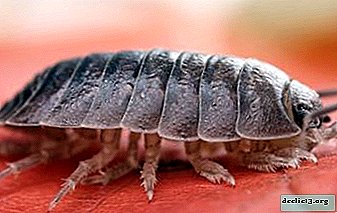Popular varieties of spathiphyllum white: description and photo

There are potted flowers that are available in almost every home, but not all owners know the names and, especially, the rules for care. Spatiphyllum belongs to such plants.
There is a belief that it brings women happiness in their personal lives, unmarried girls - narrowed, married - pregnancy. Maybe that's why it is called a female flower and it is so popular.
Check out the article about the peculiarities of the cultivation and reproduction of "female happiness", as well as a description and photos of various varieties of this plant.
Appearance
Spathiphyllum is a perennial herbaceous plant from the Aroid family. During flowering exot releases a peduncle on which white bracts surrounding the white cob. The flowers themselves are small in size, have no petals, are collected in an inflorescence resembling a miniature ear of corn. As a result of evolution around the inflorescence, a snow-white cover appeared, like a flag that attracts insects from afar.
Reference! Like other representatives of the subtropical and tropical flora, spathiphyllum does not drop foliage for the winter, so the decorative look remains year-round. The leaves are large, elongated-lanceolate, with deep veins and a glossy sheen.But the difference from other indoor plants is the lack of a stem. More precisely, it is shortened and spreads along the surface of the earth, and the leaves grow directly from the earth. Another advantage is long flowering. With proper care, spathiphyllum can delight with its flowers from March to September.
Popular varieties and their photos
To date, botanists know more than 40 varieties of "female happiness." And only a few of them are used in the field of gardening and home sprouting.
Spathiphyllum Wallis

It was named after the discoverer G. Wallis. This species is the most common variety. It is most suitable for growing in an apartment, as it is characterized by small dimensions.
The height is 20-35 cm in height. It has a white cob, a narrow oblong-shaped bedspread, which is three times as long as the cob. Wallis spathiphyllum is unpretentious in its care.
Blooming

The ancestor of this species is wild spathiphyllum, which grows in tropical forests, and there are hybrid descendants on sale. It grows up to half a meter, that is, medium in size.
Leaves are green, oval up to 20cm long. The bedspread reaches 12cm, and the peduncle 25cm. It stands out among others with abundant year-round flowering.
Charming

This species is much larger than the previous one. The difference lies in the shape and structure of the sheet. In a lovely spathiphyllum, the leaf has an elliptical shape with visually noticeable veins.
The length of the sheet plate is about 30cm. The same length of the stalk connecting the spine with the leaf. In nature, this species can be found in Suriname.
Spoon-shaped

Tall flower, reaching 1 meter in height. The shape of the leaf is oval, its width is 15 cm. The color of the leaf plate is bright green with a glossy sheen. Petiole grows up to 50-70cm. Found in the rainforests of Brazil.
Selection history
Back in the 19th century, a wonderful plant was discovered by a botanist from Germany and an ardent flower lover, Gustav Wallis. The exotic find attracted attention with the unusual shape of inflorescences and leaves. It’s still easy to find flowers in the forests of Colombia, Brazil and other parts of South America. They prefer to grow on the banks of streams, rivers, in wetlands.
Arriving in Europe and the USA, the plant impressed the breeders.
Reference! Later, hybrids of spathiphyllum for indoor cultivation began to be bred. One of the bred varieties was named after the discoverer of Wallis, who never returned from that expedition.The name of a spathiphyllum-like plant with snow-white flowers
Often, wonderful spathiphyllum is confused with other representatives of the Aroid family. But it is only beginning flower growers can make such an error, more experienced will immediately notice the difference.
They say that The most similar to spathiphyllum is zantedescia or calla. Of course, there is an external resemblance. However, if you look closely: calla foliage is quite large, heart-shaped. In the process of flowering, it releases an arrow on which inflorescences of yellow, white or pink are attached. Another difference - the calla blanket has a tubular shape.
Growing Features
In the process of growing room exot does not require special conditions. However, there are recommendations for care for the full development and lush flowering.
Care instructions
 Spathiphyllum is a shade-loving plant, but this does not mean that it does not need sunlight. It is necessary, only not scorching rays. The best option is diffuse lighting. It is recommended to put the pot in a well-lit place, it is advisable to choose window sills from the west or east side.
Spathiphyllum is a shade-loving plant, but this does not mean that it does not need sunlight. It is necessary, only not scorching rays. The best option is diffuse lighting. It is recommended to put the pot in a well-lit place, it is advisable to choose window sills from the west or east side.- An exotic plant prefers warmth. Therefore, the optimum room temperature is + 22-25 ° C, the maximum + 30 ° C, and the minimum temperature limit + 16 ° C. A temperature below + 10 ° C is critical. He does not like room exot cold air, drafts, but you should still air the room.
- Not without reason, spathiphyllum is considered a resident of the tropics, it really needs high humidity of about 50-60%. To maintain such parameters, you can put pallets with wet expanded clay, sand or use a household humidifier.
- As for watering, in the hot season, moisten should be intensively, 1 time per day. In the autumn-winter period, the amount of moisture must be reduced, during sleep to 1 time in 7-10 days. Use water without impurities.
- Be sure to fertilize the flower all year round, exclude only the dormant period. To apply complex mineral fertilizers 2-3 times a month. Before flowering, it is better to use preparations with a high content of phosphorus and potassium. And after that - complex mineral preparations.
How to transplant
Important! An indoor flower transplant is recommended every 2-3 years. It is preferable to choose the first of March. Mandatory before flowering.Soil for spathiphyllum needs a light, loose, breathable. Its main components: sheet soil, peat, ash, expanded clay, sand, mineral baking powder. There is an option to purchase the ready-made mixture for the Androids or make it yourself by choosing the right ingredients.
The process of transplantation itself is a kind of stress for the plant. The consequences after a change of soil spathiphyllum is acute for the first 1-2 weeks.
Breeding methods
 There are about three methods of plant breeding. The most successful is the method of division of the rhizome.
There are about three methods of plant breeding. The most successful is the method of division of the rhizome.
It is produced with warming, best in spring in conjunction with the transplant process.
- For breeding in the room should be kept at a temperature of 20-22 ° C.
- Each separated plot must be planted in a separate pot. The size of the container is approximately 9-10 cm in diameter.
- At the end of the procedure, pour the drug to stimulate the roots, possibly Epin or Kornevin.
Diseases and Pests
Flowers of the Aroid family are resistant to various diseases and pests. But they can still be affected by ticks, aphids that breed in dry air on hot summer days.
Important! Pests provoke deterioration of the flower’s health, leaves curl, wither, dry, and also affect the root system and inflorescences. Parasites feed on useful substances and juice, which are sucked from the plant.In the fight against insects, insecticide preparations give good results. Solutions obtained on the basis of these substances should be sprayed with spathiphyllum and soil. More gentle measures are the treatment of foliage with a soap solution.
Caring care will help to grow a real handsome man. Which, of course, will be bright objects in the interior, a kind of filter of negative energy. And, of course, bring you happiness and well-being in the family.

 Spathiphyllum is a shade-loving plant, but this does not mean that it does not need sunlight. It is necessary, only not scorching rays. The best option is diffuse lighting. It is recommended to put the pot in a well-lit place, it is advisable to choose window sills from the west or east side.
Spathiphyllum is a shade-loving plant, but this does not mean that it does not need sunlight. It is necessary, only not scorching rays. The best option is diffuse lighting. It is recommended to put the pot in a well-lit place, it is advisable to choose window sills from the west or east side.















